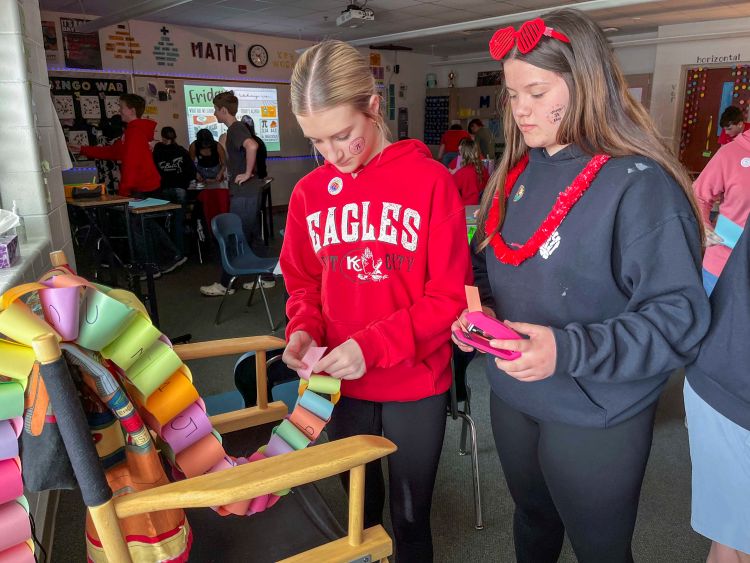Kent City — What is irrational, contains more than 200 trillion digits, and shares a special day with basketball pro Steph Curry’s birthday?
If you answered “pi” — the irrational number commonly shortened as 3.14159 — then you probably have a lot in common with Kent City Middle School math teacher Kattie Funk.
Funk and other math enthusiasts around the country celebrate the unofficial “holiday” known as Pi Day every March 14 (or 3/14). For Funk, it’s an opportunity to get kids learning about the eccentricities of math while bringing a bit of levity to a class that might otherwise be challenging.
“I love days where we can find an excuse to celebrate, because I think math can be really tough for kids sometimes,” said Funk, dressed in a pi T-shirt and pi earrings, and sporting a pi temporary tattoo on her cheek. “I try to make (math) fun for them every day, but there are some days where it’s just stressful no matter what. (Pi Day) is still math-related, but also gives us the chance to loosen up a bit and have fun with the learning.”
Pi (the Greek letter π) is the ratio of the circumference of any circle to the diameter of that circle. It is an irrational number, meaning it cannot be written as a fraction, and its decimals never repeat and never end. While it’s usually written as 3.14159 to keep things simple, at least 202 trillion digits of pi have been discovered by mathematicians as of July 2024.
For Pi Day, Funk sets up stations around her classroom for students to interact with the concept of pi in fun ways. There’s a station for writing pi poetry, a dice game using the digits of pi, “Pin the Radius on the Circle” and a paper chain that all classes contribute to by adding the next exact digit of pi. In one corner, students are challenged to measure the circumference and diameter of dozens of circular objects and try to calculate a number that’s as close to pi as possible. There’s even a Pi Day playlist thumping overhead as students immerse themselves in irrational numbers.
Of course, before the fun, there’s a lot of learning that takes place. For seventh-graders, Funk uses the week of Pi Day to explain how pi was discovered, introduce the concepts of circumference and diameter and teach them how to read a measuring tape. In her eighth-grade classes, students refresh their knowledge of the parts of a circle and work on strengthening their measuring and ratio calculation skills.
Real World, Meet Irrational Number
“Pi is kind of a tricky thing for a lot of kids — even if they’ve learned formulas to find the area of circles before, they don’t really understand what it is,” said Funk. “I try to teach them what it is, first, so that they can understand why they’re using it.
“I just think it’s cool for them to see where it comes from, and that it doesn’t matter the size of the circle, whether it’s a grain of sand or (a circle) painted on a football field, if you measure the circumference and divide it by the diameter, you will always get pi.”
Eighth-grader Liam Rath said Pi Day was “not really a holiday I celebrate unless we’re at school,” but that he’s enjoyed learning more about how the mathematical constant can be used in the real world.
“I figured out that we use it a lot for navigation of airplanes and how they’re built, and also how to build buildings so that they can survive earthquakes,” he said. “They’ll calculate the density of the building and the glass and other stuff, to see if it’ll withstand the pressure of the earth shaking. I thought that was actually really cool.”
Fellow eighth-grader Aubrey DeBoer said she was surprised to learn that pi can be found in everything circular in the world.
“It’s interesting how they found it, and how they are always discovering new digits,” she said.
Aubrey was also motivated by a signature event of Pi Day, the “Pi Bee,” where students recite or write as many digits of pi as they can remember. The winner — out of all of Funk’s classes — walked away with a free large pizza pie.
After spending a few hours studying the night before, Aubrey was able to write down 160 digits of pi from memory and emerge victorious.
“I really like pizza,” she said. “And now I know a lot more of the numbers in pi, and that it’s never-ending, and that’s pretty cool.”
Read more from Kent City:
• Science lab makes metabolic sleuths out of middle-schoolers
• An elective so fun, they don’t know it’s math












